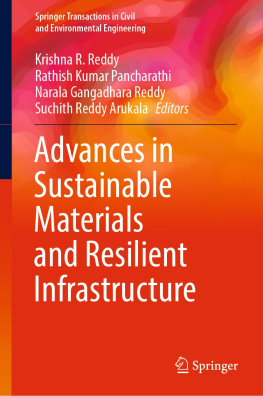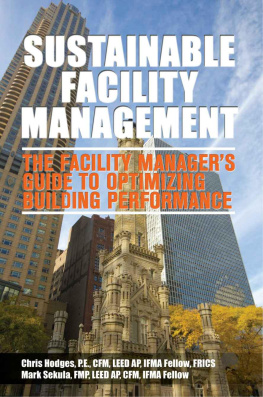
Table of Contents
List of Tables
- Chapter 01
- Chapter 02
- Chapter 03
- Chapter 04
- Chapter 05
- Chapter 06
- Chapter 07
- Chapter 08
- Chapter 09
List of Illustrations
- Chapter 01
- Chapter 02
- Chapter 03
- Chapter 04
- Chapter 05
- Chapter 06
- Chapter 08
- Chapter 09
Guide
Pages
Sustainable Construction Processes
A Resource Text
Steve Goodhew
School of Architecture, Design and Environment
Plymouth University, UK
This edition first published 2016
2016 by John Wiley & Sons, Ltd
Registered Office
John Wiley & Sons, Ltd, The Atrium, Southern Gate, Chichester, West Sussex, PO19 8SQ, United Kingdom.
Editorial Offices
9600 Garsington Road, Oxford, OX4 2DQ, United Kingdom.
The Atrium, Southern Gate, Chichester, West Sussex, PO19 8SQ, United Kingdom.
For details of our global editorial offices, for customer services and for information about how to apply for permission to reuse the copyright material in this book please see our website at www.wiley.com/wiley-blackwell.
The right of the author to be identified as the author of this work has been asserted in accordance with the UK Copyright, Designs and Patents Act 1988.
All rights reserved. No part of this publication may be reproduced, stored in a retrieval system, or transmitted, in any form or by any means, electronic, mechanical, photocopying, recording or otherwise, except as permitted by the UK Copyright, Designs and Patents Act 1988, without the prior permission of the publisher.
Designations used by companies to distinguish their products are often claimed as trademarks. All brand names and product names used in this book are trade names, service marks, trademarks or registered trademarks of their respective owners. The publisher is not associated with any product or vendor mentioned in this book.
Limit of Liability/Disclaimer of Warranty: While the publisher and author(s) have used their best efforts in preparing this book, they make no representations or warranties with respect to the accuracy or completeness of the contents of this book and specifically disclaim any implied warranties of merchantability or fitness for a particular purpose. It is sold on the understanding that the publisher is not engaged in rendering professional services and neither the publisher nor the author shall be liable for damages arising herefrom. If professional advice or other expert assistance is required, the services of a competent professional should be sought.
Library of Congress Cataloging-in-Publication Data
Names: Goodhew, Steve, author.
Title: Sustainable construction processes : a resource text / Steve Goodhew.
Description: Chichester, UK ; Hoboken, NJ : John Wiley & Sons, 2016. | Includes bibliographical references and index.
Identifiers: LCCN 2016003739 (print) | LCCN 2016008932 (ebook) | ISBN 9781405187596 (pbk.) | ISBN 9781119247944 (pdf) | ISBN 9781119247951 (epub)
Subjects: LCSH: Sustainable constructionGreat BritainTextbooks. | Sustainable buildingsGreat BritainDesign and constructionTextbooks.
Classification: LCC TH880 .G665 2016 (print) | LCC TH880 (ebook) | DDC 690.068/4dc23LC record available at http://lccn.loc.gov/2016003739
A catalogue record for this book is available from the British Library.
Wiley also publishes its books in a variety of electronic formats. Some content that appears in print may not be available in electronic books.
Cover image: Courtesy of the Author
Preface
This text follows the process of sustainable construction from an idea to the creation of a sustainable building.
When a client or architect imagines a sustainable building, there are a myriad of systems, processes, guidelines, and standards that are negotiated in the journey from blueprint to completed building.
Sustainable Construction Processes: A Resource Text provides a source guide along this journey, whilst also discussing the challenges and uncertainties that arise when constructing a building worthy of its sustainable credentials.
The idea for this book came from the need for a text, suited to Plymouth Universitys students, that would cover sustainable construction as a process rather than simply focusing on the needs of a designer. It complements but does not duplicate the many other texts on sustainable construction that focus on the design of buildings, procedures, links to sustainable development, climate change, or sustainable cities. Rather, it is concerned with how the best-laid plans of designers, planners, engineers, consultants, and project managers come to fruition, and the process though which buildings are (or are not) constructed in a fashion that makes these plans work in practice. This is a fast-moving field of study, and inevitably different policies, facts, figures, and assessment systems change with a remarkable rapidity. However, the underlying principles of how we build sustainably and the basic tools that are required for this task remain relatively static.
This book introduces the rationale and history that lie behind the drivers for sustainable construction. Decisions inform even the earliest stage of a build, such as the client deciding whether they require a new or refurbished building. From this beginning, the text follows the decision-making process for each stage of a building's life cycle to illuminate the requirements and challenges of designing, constructing, and occupying sustainable buildings. It leads the reader through the areas of sustainable procurement: how we can obtain buildings that will meet the needs of our clients, as well as the broader needs of society and the environment, without costing us and our communities too much. The elements of building design related to energy, water, and materials are examined to demonstrate how construction processes can ensure that our buildings are truly sustainable. Assessment systems are introduced and their basic underlying principles discussed. The challenge of anticipating the behaviours of occupants and the practicalities of building with some of the new sustainable technologies are considered. Finally, we consider potential areas of growth and present some contrasting visions for the future of sustainability.
About the author
Steve Goodhew is Professor of Environmental Building and Discipline Leader of the School of Architecture, Design, and Environment at Plymouth University. He has carried out research and taught in the area of sustainable construction for over 20 years. His main focus has been the assessment and monitoring of existing buildings specialising in the in situ measurement of the thermal properties of building materials, particularly the use of thermal imaging.
Steve is the Associate Head of Research and a fellow of the RICS and the CIOB. He studied at Bristol Polytechnic, London University, and Cranfield Institute of Technology, gaining his PhD from Plymouth University.
Acknowledgments
I would like to thank a range of people who have helped and encouraged me in the preparation of this book. Thanks go to Chris March for his encouragement and our initial collaborations, and to Richard Griffiths for his help with the calculations and comments concerning the scientific correctness of the text. Thank you to Richard Dawe for his procurement knowledge and to Derek Prickett and Ant Wilson, who provided texts and information pertaining to building services. Many thanks to Jane Campbell for her help in bringing the text together, for her insightful and detailed advice. To Sophie Harbour for her helpful comments and corrections. Many thanks to my family who have helped me in so many ways through the production of this book.
Next page










